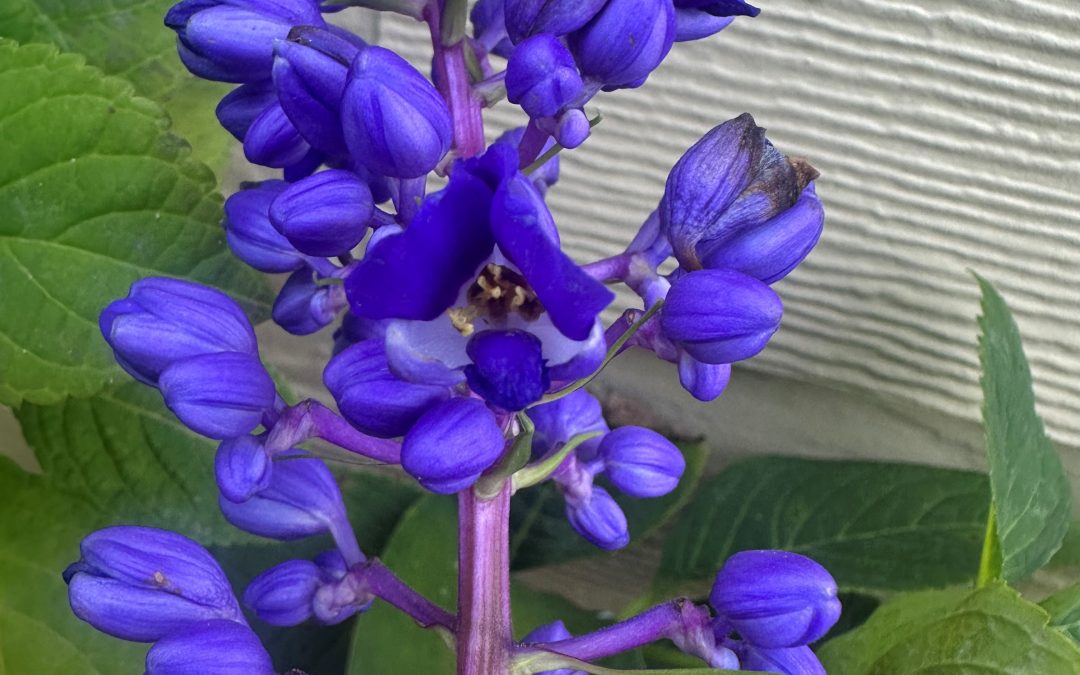
by Daniel J. Leonard | Nov 13, 2025
Fall is in the air. Halloween decorations, candy corn, mums… houses and landscapes are decked out in shades of yellow, orange, and red. However, one of the Panhandle’s absolute easiest perennials bucks the trend of autumnal hues, sports flowers of deep, brilliant blue, and is blooming right now – Blue Ginger (Dichorisandra thyrsiflora).
Blue Ginger is an unusual landscape plant for several reasons. First, the name Blue Ginger is a little bit of a misnomer. The spreading perennial species, native to southern Brazil and hardy into our zone 9, isn’t a true ginger at all, rather it resides in the Spiderwort plant family Commelinaceae, making it a close relative of other blue/purplish hued plants like Purple Heart Plant and Spiderwort. Second, it’s 10” flower spikes emerge here when few other landscape plants do (October) – after many of our summer annuals have finally sputtered out but before sasanquas and other cool season bloomers make their appearance. Rounding out Blue Ginger’s unique role in fall Panhandle landscapes is the color of its flowers. Simply calling them blue does the otherworldly color a disservice. Imagine the most striking, deep, brilliant blue you can and that will get you in the neighborhood. A Blue Ginger in flower has to be seen to be fully appreciated!
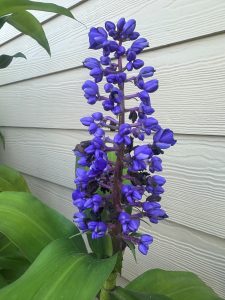
Blue Ginger flower spike. Photo courtesy of Daniel Leonard.
Adding to the appeal is that Blue Ginger is exceptionally easy to grow. However, the species does have specific growing condition needs. The ideal landscape placement for Blue Ginger is a shady oasis protected from the hot afternoon sun and blustery breeze that keeps its roots cool and moist and its succulent leaves from excessive drying. My specimen has performed excellently for over a decade on the north wall of an outbuilding, in relatively rich soil, mulched well to retain moisture, and shielded by a nearby fence. It has been years since I’ve either fertilized or watered it and the plant returns each summer, growing to about 4’ in height, and blooms each October, asking for nothing in return. One must remember the saying “Right Plant, Right Place”, as Blue Ginger can be the easiest plant ever to cultivate or a problem child that never performs like you want it to, all depending on where one sites it in the landscape.
If Blue Ginger has one drawback, it’s that it is uncommon in the nursery trade. When shopping for one, choose independent nurseries who are known to have a wide assortment of plants, maybe even a greenhouse/tropical section. I’ve never once seen Blue Ginger in a large chain nursery or box store. The best, cheapest, and most fun method of obtaining one though is to get a friend that has one to give you a cutting of their plant, as the stems root easily into new plants!
Think outside the box this fall and add some blue to your landscape with Blue Ginger. Give it a protected shady spot and a little water and it will reward your landscape with brilliant blues every October for years to come. For more information about Blue Ginger or any other horticultural topic, contact your local UF/IFAS County Extension office. Happy Gardening!
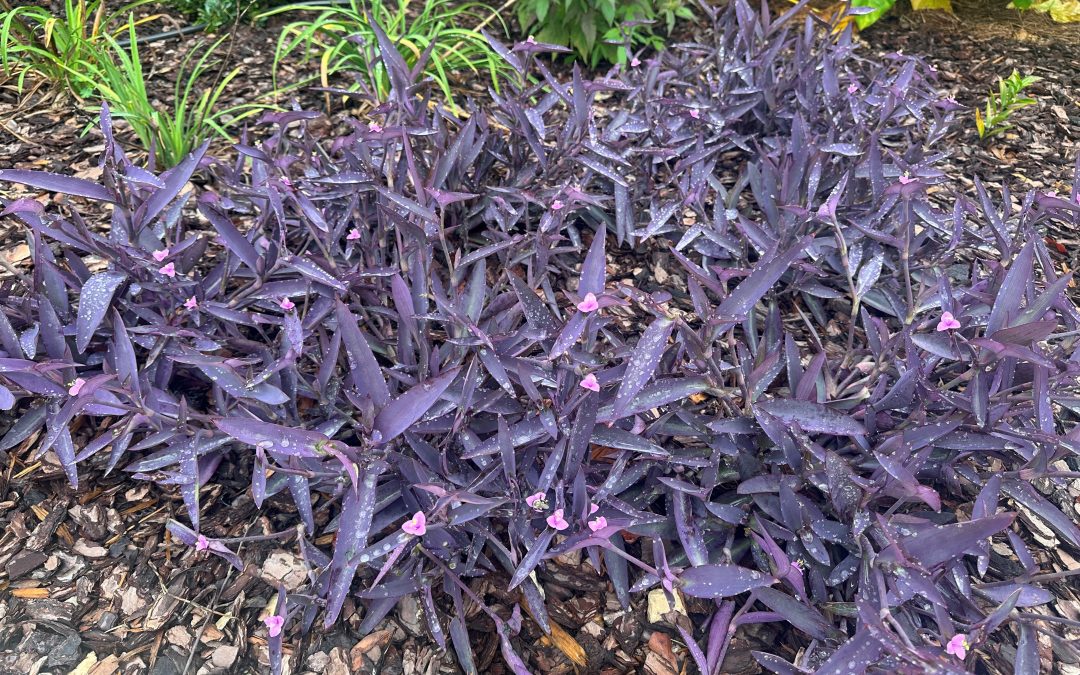
by Daniel J. Leonard | Jul 31, 2025
All gardeners dream of the perfect plant that requires no maintenance, comes back every year, and remains strikingly beautiful nearly year-round. There is one such plant in my landscape that I never have to fuss over and always looks the part. One plant stands unflinching through summer heat or winter cold. One plant is never fazed by excessive rainfall or parching drought. One plant remains unbothered by pesky insects or disease. That plant is Purple Heart (Tradescantia pallida ‘Purpurea’) and it will always have a place in my garden.
Purple Heart is a tender perennial groundcover native to tropical Mexico and, as its name might imply, purple is the primary hue the species adds to landscapes. A true all-round performer, Purple Heart offers stunning purple foliage and small purplish-pink, pollinator-attracting flowers from spring green up to the first killing frost. In some mild winters, Purple Heart even behaves as an evergreen in the Panhandle!
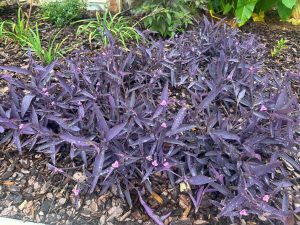
Purple Heart planting in July. Photo courtesy of Daniel Leonard.
Since attractive foliage is the primary draw with Purple Heart, siting it to maximize leaf color is important. For the deepest, most vivid shades of purple, plant in full sun; 6 or more hours of direct sunlight is ideal. Also, like many tropical plants, Purple Heart will look its best with ample moisture but, once established, is among the most drought tolerant options for Panhandle landscapes. I’ve found my Purple Heart stands look their best with occasional watering during extremely hot, dry periods, but other than that, they thrive on rainfall alone.
If there is a drawback to the species, it might be a little too vigorous and easy to grow. Because plantings can rapidly grow and expand, rooting along stems as it goes, Purple Heart can sometimes become weedy in landscapes. In my experience, Purple Heart plays nicely in the landscape with other perennials and isn’t aggressive to the point of choking out its neighbors. However, if you desire an extremely neat and orderly landscape, Purple Heart’s freewheeling nature might best be used as a spiller plant in large containers or planted in an area confined by hardscape features.
If you decide to color your landscape purple with Purple Heart, plants can be found for sale at nearly any garden center or nursery and are extremely easily propagated, making it a popular passalong plant – chances are you might know someone who would willingly share a cutting (or three) with you. For more information on this popular purple perennial or any other horticultural topic, contact your local UF/IFAS Extension county office. Happy gardening!
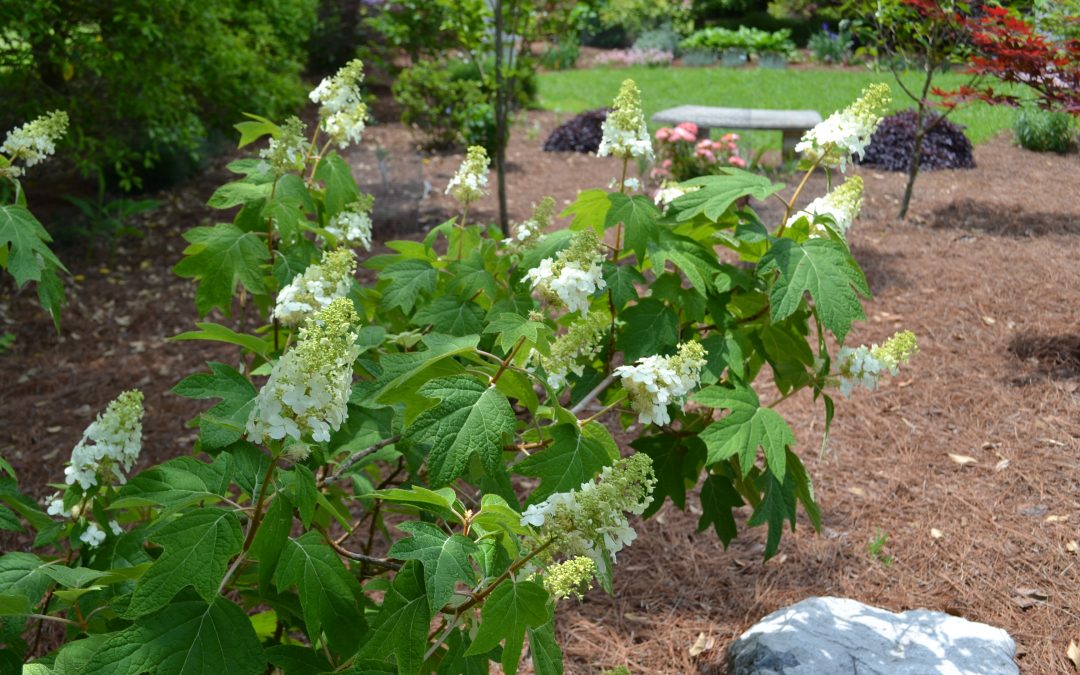
by Beth Bolles | Jun 20, 2025
Shade is a wonderful feature in the landscape as we move into our summer months. It can also offer an opportunity to include a different palette of beautiful plants the bring color and brighteness to some filtered shade or full shade locations.
Here are a few plants to consider for those low light areas of the yard.
The native oakleaf hydrangea, Hydrangea quercifolia will do well in dappled shade spots. The leaves are attractive on their own but the addition of large flowers make it very showy. This native hydrangea will like a little moisture but soils should be well drained. A little morning sun is fine but afternoon shade is very helpful as the summer months progress.
The old standard Japanese aucuba, Acuba japonica, is a favorite with it’s green leaves speckled with yellow. New growth is damaged by sun so this evergreen shrub is best with a good amount of shade. Be sure to place in a spot with good air circulation to make the environment less conducive to some plant pests.
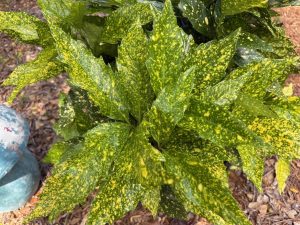
Each Aucuba leaf has a unique pattern. Photo by Beth Bolles, UF IFAS Extension Escambia County.
One of the shrimp plants that really needs shade is the White shrimp plant, Justicia betonica. Although this can be damaged in freezing weather, it is worth replanting every spring in a small grouping. Plants are easily started from cuttings and sometimes they will return from roots in the protected shade areas.
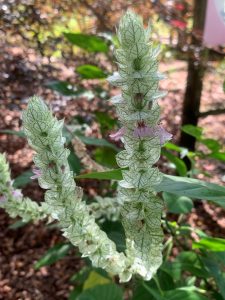
White bracts with pink flowers of White shrimp plant. Photo by Beth Bolles, UF IFAS Extension Escambia County.
An annual that is very showy for shade is related to the shrimp plant. Persian shield, Strobilanthes dyerianus is grown for it’s iridescent purple and silver foliage. It thrives in our heat with a little water when rainfall is lacking. It grows well either planted in the ground or in a container to provide bright color amongst the green foliage plants of your shady spot.
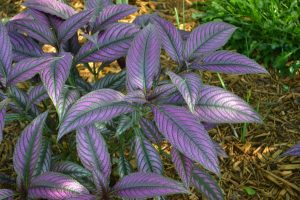
A bit of dappled morning sunlight on the Persian shield leaves. Photo by Beth Bolles, UF IFAS Extension Escambia County.
Most people know the Cast iron plant, Aspidistra elatior, which is a full shade plant. Plants that receive too much sunlight with have scalding spots. Although green foliage is attractive in summer, consider one of the cultivars with various types of variegation. You may choose a selection with white or yellow stripes through leaves or a plant with lots of white spots throughout green leaves.
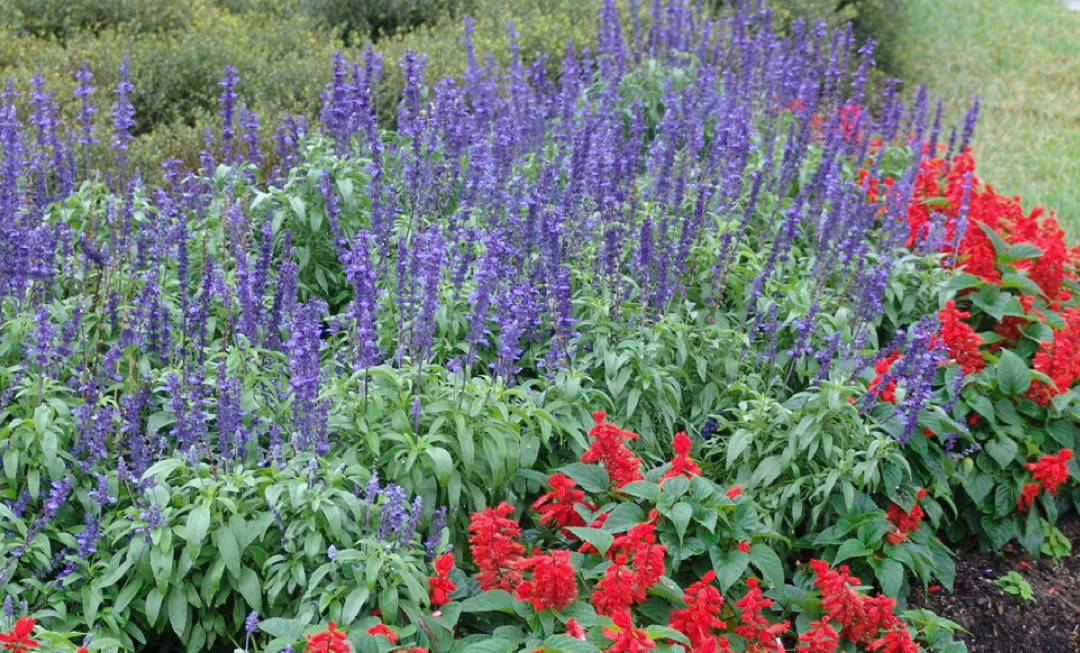
by Matt Lollar | Jan 30, 2025
Planting annuals is a great way to add color and texture to the landscape. Annuals can provide an added visual component to the garden regardless of if they’re planted in the ground or in containers, or even better—both. An annual plant completes its life cycle (growing, flowering, seed set, and death) in a single growing season. Annuals can stay in good health and last longer if they are pruned back when they get leggy and by pinching off any fading flowers (deadheading). To help plan your garden beds and container plantings please click below to enlarge the image of the handy “North Florida Annual Planting Guide”. Please note the suggested planted dates in this guide are based on average monthly temperatures, but every year is different. Some years we may have a late frost around Easter, other years we won’t have a cold front after February.


by Daniel J. Leonard | Sep 19, 2024
Problem areas in the landscape – everyone has them. Whether it’s the spot near a drain that stays wet or the back corner of a bed that sunshine never touches, these areas require specialized plants to avoid the constant frustration of installing unhealthy plants that slowly succumb and must be replaced. The problem area in my landscape was a long narrow bed, sited entirely under an eave with full sun exposure and framed by a concrete sidewalk and a south-facing wall. This bed stays hot, it stays dry, and is nigh as inhospitable to most plants as a desert. Enter a plant specialized to handle situations just like this – Yarrow ‘Moonshine’.
Yarrow (Achillea spp.) is a large genus of plants, occurring all over the globe. To illustrate, Common Yarrow (Achillea millefolium) is native to three different continents (North America, Europe, and Asia), making it one of the most widely distributed plants in the world. And though it was commonly grown and used in antiquity for medical purposes (the genus name Achillea is a reference to Achilles, who supposedly used the plant as a wound treatment for himself and his fellow Greek soldiers), I and most of you are probably more interested in how it looks and performs in the landscape.

‘Moonshine’ Yarrow foliage.
All species of Yarrow share several ornamental traits. The most obvious are their showy flowers, which occur as large, flattened “corymbs” and come in shades of white, pink, red, and yellow. I selected the cultivar ‘Moonshine’ for my landscape as it has brilliant yellow flowers that popped against the brown wall of the house. Equally as pretty and unique is the foliage of Yarrow. Yarrow leaves are finely dissected, appearing fernlike, are strongly scented, and range in color from deep green to silver. Again, I chose ‘Moonshine’ for its silvery foliage, a trait that makes it even more drought resistant than green leaved varieties.

‘Moonshine’ Yarrow inflorescence.
If sited in the right place, most Yarrow species are easy to grow; simply site them in full sun (6+ hours a day) and very well drained soil. While all plants, Yarrow included, need regular water during the establishment phase, supplemental irrigation is not necessary and often leads to the decline and rot of Yarrow clumps, particularly the silver foliaged varieties like ‘Moonrise’ (these should be treated more like succulents and watered only sparingly). Once established, Yarrow plants will eventually grow to 2-3’ in height but can spread underground via rhizomes to form clumps. This spreading trait enables Yarrow to perform admirably as a groundcover in confined spaces like my sidewalk-bound bed.
If you have a dry, sunny problem spot in your landscape and don’t know what to do, installing a cultivar of Yarrow, like ‘Moonshine’, might be just the solution to turn a problem into a garden solution. This drought tolerant, deer tolerant, pollinator friendly species couldn’t be easier to grow and will reward you with summer color for years to come. Plant one today. For more information on Yarrow or any other horticultural question, contact your local UF/IFAS County Extension Office.













